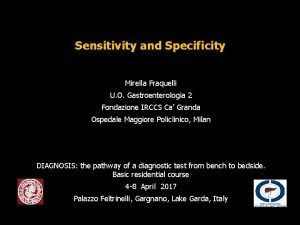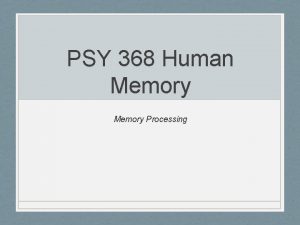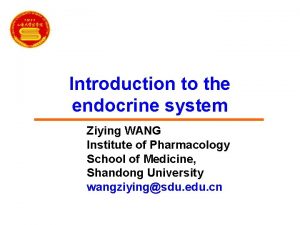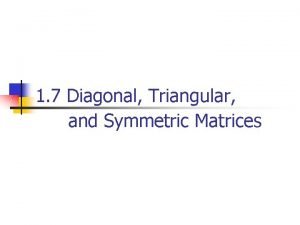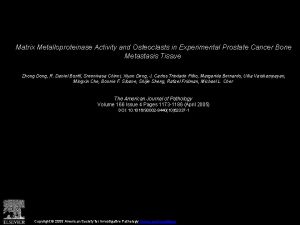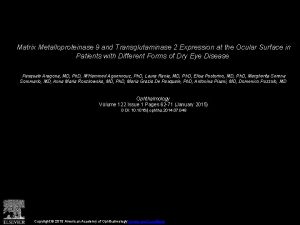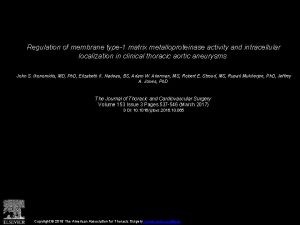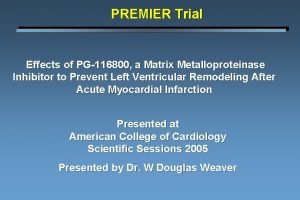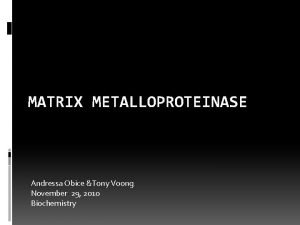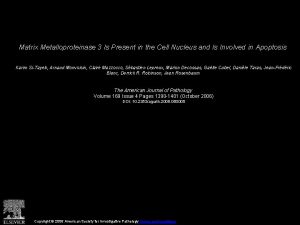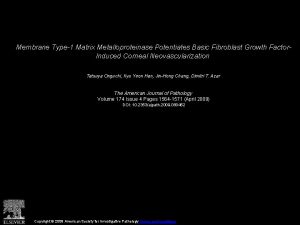Sensitivity and Specificity of a PointofCare Matrix Metalloproteinase









- Slides: 9

Sensitivity and Specificity of a Point-of-Care Matrix Metalloproteinase 9 Immunoassay for Diagnosing Inflammation Related to Dry Eye Sambursky R, Davitt WF III, Latkany R, et al. Sensitivity and specificity of a point-of-care matrix metalloproteinase 9 immunoassay for diagnosing inflammation related to dry eye. JAMA Ophthalmol. 2013; 131(1): 24 -28. Copyright restrictions may apply

Introduction • A study was conducted to determine the clinical sensitivity, specificity, negative predictive value, and positive predictive value of a rapid point-of-care diagnostic test to detect elevated matrix metalloproteinase 9 (MMP-9) levels (Inflamma. Dry). • MMP-9 is an inflammatory biomarker that Copyright restrictions may apply has been shown to be elevated in the

Methods • Study Design: Prospective, sequential, masked, multicenter clinical trial. • Inflamma. Dry was performed on 206 patients. – 143 with clinical signs and symptoms of dry eyes and 63 healthy control subjects. • Patients were assessed as healthy control Copyright restrictions may apply subjects or for a clinical diagnosis of dry

Methods Copyright restrictions may apply

Results • Compared with clinical assessment, the Inflamma. Dry test is sensitive and specific at diagnosing dry eye. • Inflamma. Dry showed a sensitivity of 85% (121 of 143 patients), a specificity of 94% (59 of 63 patients), a negative predictive value of 73% (59 of 81 patients), and a positive predictive value of 97% (121 of 125 Copyright restrictions may apply patients).

Results Copyright restrictions may apply

Comment • Dry eye is often underdiagnosed owing to the disconnect between the clinical assessment of dry eye severity by clinicians and patients. This often leads to a lack of effective treatment. • Chronic dry eye syndrome was characterized in the 2007 Report of the Dry Eye Workshop into levels of severity Copyright restrictions may apply based on the presence or absence of a

Comment • Reducing ocular inflammation is the target for many dry eye therapeutics. – Topical cyclosporine treatment inhibits Tlymphocyte proliferation and decreases the levels of MMP-9 expression in conjunctival epithelial cells. – Corticosteroids inhibit inflammation and decrease the production of inflammatory cytokines and MMP-9 by the corneal epithelium. – Doxycycline preserves the tight junction network, Copyright restrictions may applyincreases corneal smoothness,

Contact Information • If you have questions, please contact the corresponding author: – Robert Sambursky, MD, Manatee Sarasota Eye Clinic and Laser Center, 13946 Wood Duck Cir, Bradenton, FL 34202 (robsambo@yahoo. com). Conflict of Interest Disclosures • Dr Sambursky has an affiliation with Rapid Pathogen Screening, Inc; however, none of the principal investigators have any Copyright restrictions may apply
